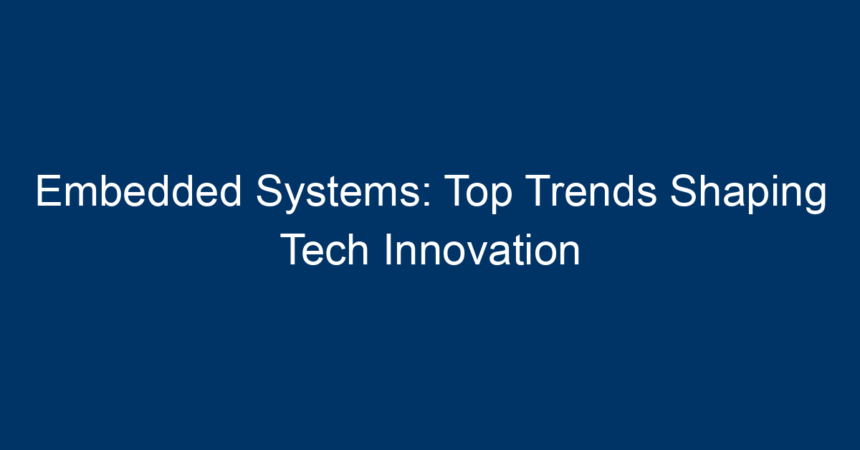Embedded systems have become integral to numerous industries, from automotive to healthcare, enhancing functionality, reducing costs, and improving overall performance. As technology evolves, several trends are shaping the evolution of embedded systems, driving tech innovation in exciting new directions. In this article, we will explore these trends and their implications for the future of embedded systems, ensuring you stay ahead in this rapidly changing landscape.
What are Embedded Systems?
Before diving into the trends, it’s essential to understand what embedded systems are. An embedded system is a combination of hardware and software designed to perform specific tasks within a larger mechanical or electrical system. Unlike general-purpose computers, embedded systems are optimized for particular applications, making them efficient and reliable.
Characteristics of Embedded Systems
- Real-Time Operation: Many embedded systems operate under tight deadlines.
- Reliability: These systems must perform consistently and accurately.
- Low Power Consumption: Efficient power usage is crucial, especially in portable devices.
- Compact Size: Embedded systems tend to be small in scale, fitting within the products they serve.
Key Trends in Embedded Systems
1. The Rise of IoT (Internet of Things)
The Internet of Things has transformed embedded systems by making them more interconnected. Smart devices now collect, analyze, and share data in real-time. By integrating embedded systems with IoT capabilities, manufacturers are creating devices that offer unprecedented functionality.
Why It Matters
- Data Analytics: IoT-enabled embedded systems can gather insightful data, allowing businesses to make informed decisions.
- Remote Monitoring: These systems enable remote access and maintenance, reducing downtime and enhancing user satisfaction.
2. Artificial Intelligence and Machine Learning Integration
AI and machine learning are gradually being incorporated into embedded systems, adding intelligence to traditional functionalities. This integration allows devices to learn from user behaviors and adapt over time.
Applications in Different Sectors
- Automotive: AI-driven embedded systems enhance safety features like lane-keeping assistance and adaptive cruise control.
- Healthcare: Smart medical devices use machine learning algorithms to monitor patient health and predict potential issues.
3. Advanced Security Measures
As embedded systems become more connected, they are increasingly vulnerable to cyber threats. Therefore, security has become a paramount concern. Manufacturers are now focusing on embedding robust security features directly into their products.
Security Enhancement Techniques
- Encryption: Ensuring that data transmitted over networks is secure.
- Secure Booting: Protecting devices from unauthorized software.
4. Reduced Size, Enhanced Functionality
Miniaturization has been a significant trend in embedded systems. Advances in semiconductor technology allow engineers to create smaller, more efficient components, leading to compact designs without compromising performance.
Benefits of Miniaturization
- Cost Efficiency: Smaller components lower manufacturing costs.
- Versatility: Compact designs make embedded systems suitable for a broader range of applications.
5. Edge Computing
Edge computing has gained traction in recent years as it reduces the latency associated with cloud computing. By processing data closer to its source, embedded systems can deliver near-instantaneous results.
Edge Computing in Action
- Smart Cities: Traffic management systems manage data locally to optimize traffic flow and reduce congestion.
- Manufacturing: Real-time monitoring of machines ensures immediate responses to operational issues.
6. Open Source Software Adoption
The rise of open-source software is another critical trend influencing the development of embedded systems. Developers are leveraging community-driven resources to accelerate innovation and reduce costs.
Advantages of Open Source in Embedded Systems
- Collaboration: Encourages shared knowledge and collaborative problem-solving.
- Flexibility: Open-source systems can be customized to meet specific application needs.
7. Wireless Technologies
The transition to wireless embedded systems is increasingly prevalent, driven by the need for connectivity without the constraints of physical cables. Technologies such as Bluetooth, Wi-Fi, and Zigbee are critical in developing smart and flexible devices.
Applications of Wireless Embedded Systems
- Wearable Technology: Health monitors and fitness trackers rely on wireless communication for real-time data sharing.
- Smart Home Devices: Wireless embedded systems enable seamless integration with home networks, enhancing user convenience.
Future Outlook for Embedded Systems
The future of embedded systems is bright, driven by continued investments in research and development. As we move forward, we can expect several notable advancements:
Advanced Sensor Technologies
- New sensor types will enable embedded systems to gather more data, enhancing capabilities in industries like agriculture, environmental monitoring, and healthcare.
Increasing Role of 5G Technology
- The introduction of 5G will facilitate faster communication, allowing for more advanced real-time applications, especially in autonomous vehicles and smart cities.
Actionable Insights
To stay ahead in the field of embedded systems, consider the following strategies:
-
Invest in Continuous Learning: Stay updated on the latest trends and technologies in embedded systems. Online courses, webinars, and industry conferences are great resources.
-
Embrace Innovation: Be open to adopting new technologies, like AI and edge computing, that can enhance the functionality of your products.
-
Prioritize Security: As products become more connected, integrating security measures during the design phase will become increasingly important.
-
Leverage Open Source: Explore open-source projects to accelerate development and share knowledge with the community.
- Focus on User Experience: Design embedded systems with the end-user in mind, ensuring that interfaces are intuitive and functionalities seamless.
Conclusion
Embedded systems are at the forefront of technological innovation, and understanding the trends shaping this field is crucial for anyone looking to leverage these advancements. By embracing IoT, AI integration, enhanced security measures, miniaturization, and other emerging trends, businesses can unlock new opportunities and deliver unparalleled value to their users. As we move forward, the possibilities for embedded systems are limitless, paving the way for a smarter, more connected future.
Stay informed, remain agile, and be prepared to adapt—success in the world of embedded systems depends on it!




